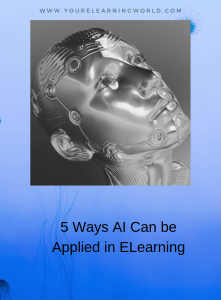 Artificial intelligence (AI) has become a mainstay in virtually all aspects of human life. And now, its presence is reinforcing education in the aspect of eLearning more than any other modern technology.
Artificial intelligence (AI) has become a mainstay in virtually all aspects of human life. And now, its presence is reinforcing education in the aspect of eLearning more than any other modern technology.
Today, AI impacts the modern educational system in the areas of adaptive learning, virtual teachers and lecturers, customized digital learning interfaces, automated grading, and the automated plagiarism checking, as per report presented in this infographic.
Machine learning, an aspect of AI, enables machines to learn and make decisions for themselves based on the analysis of statistical data, behavior patterns, and even the outcomes of previous actions (learning by trial and error). In 2017, Netflix saved $1 billion by using machine learning and that’s only one of the positive examples of AI use.
A very basic example of the machine learning application is the classification of spam mail that most mail servers incorporate. Thus, by taking as reference a series of labels such as certain words or symbols in the subject or body of the message, the system is able to send certain emails to the spam folder automatically.
To make this automatic learning as efficient as possible, the machines need to absorb a lot of data. This is where big data comes into play.
The technology of processing large volumes of data allows us to classify and generate reliable algorithms so that the machines increase their learning capacity.
These AI systems could be really useful when implemented in eLearning. Let’s check why.
Adaptive Learning
ELearning systems are adaptable to different learning styles because they offer specific didactic content depending on the reaction of each learner to specific stimuli. With this, the identification of possible needs of a learner, his or her deficiencies, or problems on the learning material of a
particular course is easier done.
Collection of Helpful Additional Learning Resources
AI helps in the automated collection of data external to a specific course, which complements the material in a useful and practical way for the learners. This system helps to enrich and entertain the learning experience of the learners since it collects additional relevant studying material for
them.
Personalized Learning
In addition, we can say that AI systems offer learners a unique and personalized learning experience through specific training plans for each person. In this sense, an AI system can be used as a stimulator of a specific course to help motivate the learners, reminding them to perform certain tasks, offering advice, and sending feedback on the work delivered, among other aspects.
Virtual Assistants as Teaching Assistants
AI systems such as chatbots offer virtual assistant services. Therefore, at any time, learners can contact the organization of the course and resolve questions in a few minutes. Something really useful both for the organizer of the course and for the learners.
Distance Education
Thanks to technology, education no longer has limits – global learning is now a possibility as AI can help eliminate boundaries. This technology can facilitate the learning from any location around the globe as AI applications can automatically alter lectures and course material to suit the language and tradition of learners worldwide.
In conclusion, we can say that eLearning can be greatly complemented by the good use of AI systems.


Leave a Reply